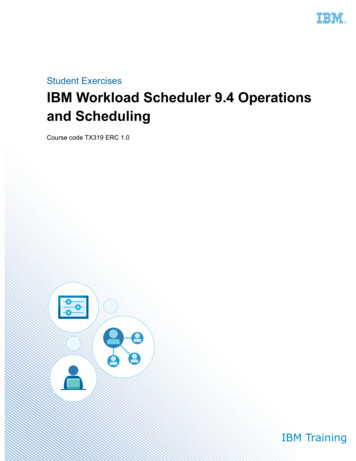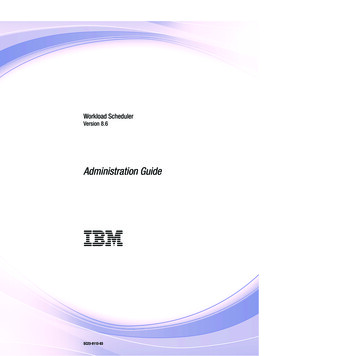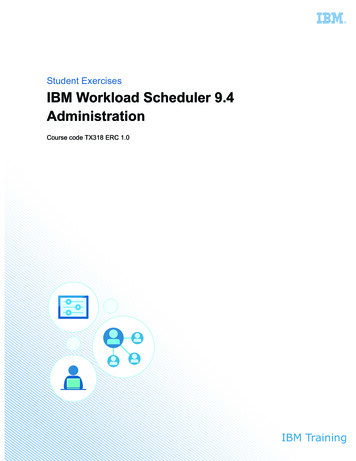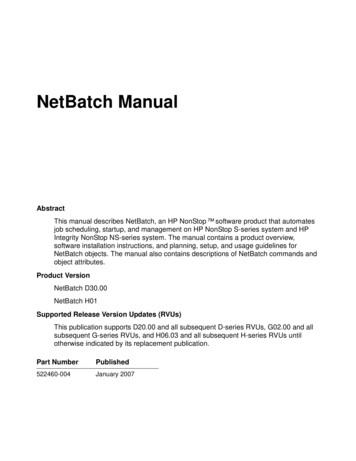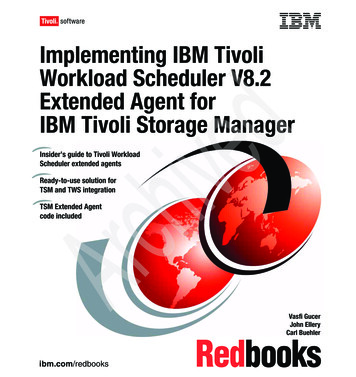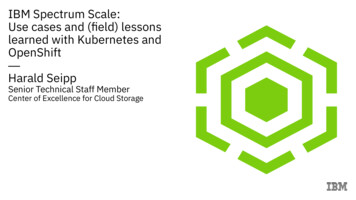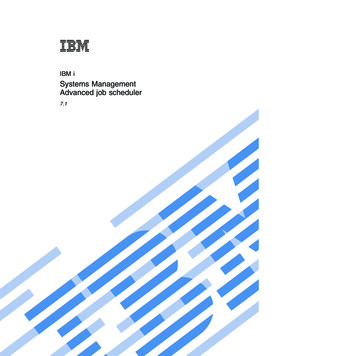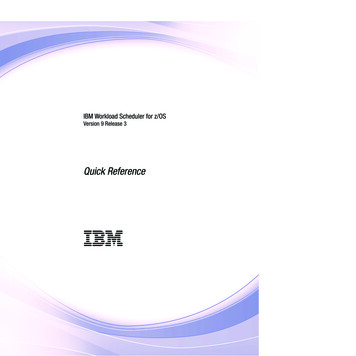
Transcription
IBM Workload Scheduler for z/OSVersion 9 Release 3Quick Reference
IBM Workload Scheduler for z/OSVersion 9 Release 3Quick Reference
NoteBefore using this information and the product it supports, read the information in “Notices” on page 39.This edition applies to version 9, release 3, modification level 0 of IBM Workload Scheduler (program number5698-WSH) and to all subsequent releases and modifications until otherwise indicated in new editions. Copyright IBM Corporation 1999, 2015.US Government Users Restricted Rights – Use, duplication or disclosure restricted by GSA ADP Schedule Contractwith IBM Corp.
ContentsFigures . . . . . . . . . . . . . . . vAbout this publication . . . . . . . . viiSupport information . viiChapter 1. Using the ISPF dialogs . . . 1Specifying list criteria . . . .Using generic search arguments .Sorting list output . . . . .Locating data strings in list outputGraphically displaying lists . .PF key assignment . . . . .122223Chapter 2. TSO commands . . . . . . 5BACKUPBULKDISCJSUACT .OPINFO .OPSTAT .SRSTAT .WSSTAT .5556677Chapter 3. Commands to control thescheduler . . . . . . . . . . . . . . 9Starting the scheduler .Stopping the scheduler .Canceling the schedulerModifying the schedulerModifying the data store. 9. 9. 10. 10. 17Chapter 4. Automatic recovery . . . . 19RECOVER statement . 19Chapter 5. JCL directives . . . . . . . 21NOP directive . .SCAN directive . .SEARCH directive .TABLE directive . .SETFORM directive. Copyright IBM Corp. 1999, 2015.2121212121Usage notes . . . . . . . .SETVAR directive . . . . . . .Usage notes . . . . . . . .BEGIN and END directives . . . .FETCH directive. . . . . . . .COMP keyword on BEGIN and FETCHUsage notes . . . . . . . . . . . . . . . . . . . . . . .directives. . . .212222222223. 23Chapter 6. Supplied JCL variables . . . 25Occurrence-related JCL variables .Operation-related JCL variables. .Date-related JCL variables . . .Dynamic-format supplied variables.25262627Chapter 7. Codes . . . . . . . . . . 29Operation status codes . .Extended status codes . . .Error codes . . . . . .Job log retrieval status codesOperation reason codes . .2929303333Chapter 8. Free-day rule . . . . . . . 35Chapter 9. Defining day to dayworkload . . . . . . . . . . . . . . 37Job related. . . . . . . . . . . .NOERROR syntax for JCL return codemanagement . . . . . . . . . .USRREC syntax for end-to-end schedulingModeling related for end-to-end schedulingCPUREC . . . . . . . . . . .DOMREC . . . . . . . . . . . 37.3737373738Notices . . . . . . . . . . . . . . 39Trademarks . . . . . . . . . . . . .Terms and conditions for product documentation. 41. 41Index . . . . . . . . . . . . . . . 43iii
ivIBM Workload Scheduler for z/OS: Quick Reference: Quick Reference
Figures1.EQQSOPFP - Selecting Operations . Copyright IBM Corp. 1999, 2015. 1v
viIBM Workload Scheduler for z/OS: Quick Reference: Quick Reference
About this publicationIBM Workload Scheduler for z/OS: Quick Reference is a handy guide to the morecommonly used dialogs, commands, and directives of IBM Workload Scheduler forz/OS.The term scheduler, when used in this publication, refers to IBM WorkloadScheduler for z/OS. The term DB2 , when used in this publication, refers toDATABASE 2 and DB2 Universal Database .The term z/OS is used in this publication to mean z/OS and OS/390 operatingsystems. Where the term OS/390 appears, the related information applies only toOS/390 operating systems.Support informationIBM provides several ways for you to obtain support when you encounter aproblem.If you have a problem with your IBM software, you want to resolve it quickly. IBMprovides the following ways for you to obtain the support you need:v Searching knowledge bases: You can search across a large collection of knownproblems and workarounds, Technotes, and other information.v Obtaining fixes: You can locate the latest fixes that are already available for yourproduct.v Contacting IBM Software Support: If you still cannot solve your problem, andyou need to work with someone from IBM, you can use a variety of ways tocontact IBM Software Support.For more information about these three ways of resolving problems, see theappendix on support information in IBM Workload Scheduler: Troubleshooting Guide. Copyright IBM Corp. 1999, 2015vii
viiiIBM Workload Scheduler for z/OS: Quick Reference: Quick Reference
Chapter 1. Using the ISPF dialogsTable 1. Some primary commands for panelsCommandActionRETURNReturn to main menu. An end operation is run for each panel in thesequence leading back to the main menu (all changes on theindividual panels are saved).CANCELReturn to the previous panel without making any changes.RIGHTDisplay the right part of the data. This is available only from panelsthat have the text LEFT PART in the panel title.LEFTDisplay the left part of the data. This is available only from panelsthat have the text RIGHT PART in the panel title.HELPDisplay help information.SORTSort information in a list.LOCATE lparmScroll to the field specified. If the field is not found, the list isdisplayed starting with the entry before which the specified fieldwould have occurred. If the list is sorted by application name, lparmis the name of the application; if sorted by job name, lparm is a jobname.GRAPHDisplay a network of dependencies.GDDMExecute Graphical Data Display Manager (GDDM) functions on agraphically displayed network.ATTRSet graphic attributes.Specifying list criteriaLimit the length of lists by using filter panels like the SELECTING OPERATIONSpanel:EQQSOPFP ------------------- SELECTING OPERATIONS --------------------------Command Specify selection criteria below and press ENTER to create an operation list.JOBNAME P*WORK STATION NAME APPLICATION ID OWNER ID AUTHORITY GROUP PRIORITY GROUP DEFINITION STATUS CLEAN UP TYPE CLEAN UP RESULT OP. EXTENDED NAME OP. SE NAME Input arrival in format YY/MM/DD HH.MMFROM TO Additional OptionsFAST PATHMANUALLY HELDWAITING FOR SESTARTED ON WAIT WS( Y N ) Y Valid only along with jobnameLeave blank to select allLeave blank to select allFigure 1. EQQSOPFP - Selecting OperationsYou can use blanks, complete names, IDs, or search arguments in the input fields. Copyright IBM Corp. 1999, 20151
On some selection panels you can choose the fastpath option, so that IBM WorkloadScheduler for z/OS searches for matching job names on automatic workstations. Ifthere is a matching job name, IBM Workload Scheduler for z/OS includes alloperations with that job name, whether on an automatic workstation or not.Using generic search argumentsMany of the input fields in the dialog accept generic search arguments. Use anasterisk (*) to represent any character string or a null string. Use a percent sign (%)for any single character.To select all application identifiers whose first three letters are PAY, enter this inthe input field:APPLICATION ID PAY*To select all applications where P is the first letter and Y is the third letter, enterthis:APPLICATION ID P%Y*Sorting list outputIn all list displays, enter the SORT command to display a panel where you canspecify the order of the list items. The sort order you request remains in effect forthat specific list type until changed.If you sort on date fields, take into account the date format that has been specified,because this can affect the order.Locating data strings in list outputEnter LOCATE on any list display panel to find a data string in the list. Thecommand also supports generic search strings. For example, you can enter LOCATEABC* to find any item in the list beginning with ABC. Locate scrolls to the fieldspecified.If the list is sorted by application name, request LOCATE applname; similarly, ifsorted by job name, request LOCATE jobname. If you need to issue a locatecommand on a list that is not sorted by the item you want to locate, change theorder with the SORT command.Graphically displaying listsIf you have GDDM installed and have a terminal capable of displaying graphics,you can also display lists of applications, occurrences, and operations graphically.Graphic displays contain the same information as edit or selection lists, but theformat is different; you can see dependency connections that might be hard to seefrom a conventional list.To see a graphically displayed list, enter GRAPH at the command prompt of a panelon which graph is an option.2IBM Workload Scheduler for z/OS: Quick Reference: Quick Reference
PF key assignmentThe dialog maintains separate program function (PF) keys from your normal ISPFkey assignments. Enter KEYS at the command prompt to display or change thecurrent assignment.You can define PF keys to run a command that you use regularly, for example, todisplay the ready list. To ensure that the command will be run correctly, regardlessof the panel it is entered from, define the PF key like this:PF5 ; 4.1.cpu1Where ; is your ISPF command delimiter.You can define unique PF key assignments for different panels. For example, if youregularly use the application description dialog, you can define PF keys for theOPER and RUN commands.It is recommended that you do not alter the key assignments for PF1 (HELP), orPF12 (RETRIEVE). The retrieve PF key returns the command you last run to thecommand prompt. A stack of approximately 25 commands is maintained.The PF KEY DEFINITIONS AND LABELS panel lets you assign labels to the PFkey definitions. When you enter the PFSHOW command from a panel, the PF keylabels are displayed. To remove the display, enter PFSHOW OFF.Chapter 1. Using the ISPF dialogs3
4IBM Workload Scheduler for z/OS: Quick Reference: Quick Reference
Chapter 2. TSO commandsThis chapter describes the syntax for the IBM Workload Scheduler for z/OS TSOcommands, BACKUP, BULKDISC, JSUACT, OPINFO, OPSTAT, SRSTAT, andWSSTAT.You can abbreviate keywords to their shortest unambiguous form. For example,you can shorten the AVAIL keyword to an ‘A’. Before you invoke an IBMWorkload Scheduler for z/OS TSO command, you must allocate the EQQMLIBdata set to the TSO address space, either by adding DD statements to the logonprocedure, or by using the ALLOC command after TSO logon. Error messages aresent directly to the terminal.The TSO commands can be directed to a specific IBM Workload Scheduler forz/OS subsystem (tracker). The tracker does not have to be active when you issuethe command. An event is generated and queued in ECSA along with otherjob-tracking events.BACKUP BACKUP RESDS (CPJS) 0trace levelTRACE () SUBSYS (OPCAMSTRsubsystem name)BULKDISC BULKDISC TRACE (0trace level) SUBSYS (OPCAMSTRsubsystem nameCRITJ)JSUACT ACT (JSUACTyesno) SUBSYS ( Copyright IBM Corp. 1999, 2015OPCAMSTRsubsystem name)5
0trace levelTRACE ()TYPEHFB()OPINFO OPINFO ADID(application description identifier) CLASS (printer sysout class) FORM(printer form name)IA(yymmddhhmm) JOBNAME (job name)OPNUM (operation number) OPCAMSTRsubsystem nameSUBSYS ()TRACE (0trace level) USERDATA (any data)WSNAME (workstation name)OPSTAT OPSTAT ADID(appl description ID) CLASS (printer sysout class)DURATION (hhmm) ERRORCODE (operation error code)EVDATE (yymmdd EVTIME (hhmm)FORM(printer form name) IA(yymmddhhmm)JOBNAME (nnnnnn)OPNUM (job name) NUMJOB (6)IBM Workload Scheduler for z/OS: Quick Reference: Quick Referenceoperation number)
TOKEN (token value)CEIQTSXSTATUS () OPCAMSTRsubsystem name) WSNAME (workstation name) SRSTAT 'resource nameSUBSYS (0trace levelTRACE () SRSTAT' KEEPRESETNOYESAVAIL () YESNOCREATE ()KEEPamountRESETDEVIATION () LIFESPAN (interval, new availability valueQUANTITY (KEEPamountRESET) )OPCAsubsystem nameMSTRSUBSYS () TRACE (0trace level)WSSTAT WSSTAT ALTWS (alternate workstation name) REROUTE (RL)STARTOPR (RLE)Chapter 2. TSO commands7
CMD(MANAGES (STATUS (LPSU) SUBSYS (domain manager nameA)OFTRACE (80trace level))WSNAME ( OPCAsubsystem nameMSTR)IBM Workload Scheduler for z/OS: Quick Reference: Quick Referenceworkstation name)
Chapter 3. Commands to control the schedulerYou can start, stop, cancel, or modify the scheduler by using the following operatorcommands:SSTARTPSTOPCCANCELFMODIFYIn addition, you can use the MODIFY (F) command to start and stop individualsubtasks.You can enter these commands from a multiple console support (MCS) console orfrom a program such as the spool display and search facility (SDSF). In both cases,the terminal or console operator must have the required authority to enter operatorcommands.Starting the schedulerTo start IBM Workload Scheduler for z/OS, enter the following z/OS operatorcommand:/S procnamewhere procname is the IBM Workload Scheduler for z/OS JCL procedure name.If a started task with this name is already active, the second attempt to invoke itends with an error message. If this happens, the started task in error cannot writean error message to the message log (ddname EQQMLOG) because the messagelog is already being used by the active started task. If IBM Workload Scheduler forz/OS is to run as a batch job, do not start it with an operator command. Instead,submit a batch job with the same name as IBM Workload Scheduler for z/OSsubsystem. JES starts this job in the same manner as any ordinary job.Note: Because IBM Workload Scheduler for z/OS uses JES exits, among otherthings, to track the progress of z/OS jobs, it does not start before JES is active.Stopping the schedulerTo stop IBM Workload Scheduler for z/OS, enter the following z/OS operatorcommand:/P procnamewhere procname is the IBM Workload Scheduler for z/OS JCL procedure name.If you are stopping a controller, the controller creates a backup copy of the currentplan data set (if required) and ends all active functions.When IBM Workload Scheduler for z/OS ends, it writes this message to themessage log:EQQZ086I NO ACTIVE OPC SUBTASKS.OPC IS ENDING Copyright IBM Corp. 1999, 20159
Canceling the schedulerIf IBM Workload Scheduler for z/OS is still active 5 minutes after you enter theSTOP operator command, you must cancel IBM Workload Scheduler for z/OS.You may also need to cancel IBM Workload Scheduler for z/OS if the current planis corrupt, because a normal shutdown causes a backup to the alternate file (referto Customization and Tuning for details of current plan recovery). There are twoways to do this. The first is to enter the following operator command:/C procname,DUMPwhere procname is the IBM Workload Scheduler for z/OS JCL procedure name.This causes IBM Workload Scheduler for z/OS to end with a dump on theSYSMDUMP file (if the ddname is in the started-task JCL). The second way is toenter:/C procnamewhere procname is the IBM Workload Scheduler for z/OS JCL procedure name.This causes IBM Workload Scheduler for z/OS to end without a dump.If the STOP command is ineffective and you have no earlier documentation of theproblem, cancel IBM Workload Scheduler for z/OS with a dump so that the errorcan be located.Modifying the schedulerBy using the MODIFY command, you can supply information to IBM WorkloadScheduler for z/OS after it has started. The syntax of the MODIFY command is:/F procname,modifyoptionwhere:procnameIs the IBM Workload Scheduler for z/OS JCL procedure name.modifyoptionCan be one of the following:S tasknameStarts the specified subtask.P tasknameStops the specified subtask.taskname can be one of the following:APPC APPC subtask.ARAutomatic recovery subtask.A4APPC tracker router subtask.CPHCritical path handler subtask.DRTData router subtask.EMGREvent manager subtask.10IBM Workload Scheduler for z/OS: Quick Reference: Quick Reference
ERDR All active event-reader subtasks.EWTR Event writer subtask.EXAExternal router subtask.FLFetch job log task.GENGeneral service subtask.IPTCP/IP router subtask.JCCJob-completion-checker subtask.NMM Normal-mode-manager subtask. The normal modemanager must be restarted as soon as possible after it hasstopped. Many functions of IBM Workload Scheduler forz/OS require an active NMM task to execute successfully.PENF53Deactivates the ENF mechanism implemented for the ENF53 event. In this way, a dynamic time change for all theIBM Workload Scheduler for z/OS subsystems cannot beperformed. By default, the ENF 53 mechanism isautomatically deactivated when the controller is stopped.PSUPre-submit task.RODMRODM subtask.SENF53Activates the ENF mechanism implemented for the ENF 53event, so that a dynamic time change for all the IBMWorkload Scheduler for z/OS subsystems can beperformed. By default, the ENF 53 mechanism isautomatically activated at controller startup.SUBSubmit subtask.TWSEnd-to-end with fault tolerance capabilities task.VTAM Network communication function (NCF) subtask.WSAWorkstation analyzer subtask.Only the tasks in IBM Workload Scheduler for z/OS subtask tablecan be activated by a MODIFY command. The subtask table isbuilt when IBM Workload Scheduler for z/OS is started. Thismeans that you can only start a task that has stopped earlier in thecurrent session. If you attempt to start a started subtask or stop astopped subtask, error message EQQZ049W is issued, and noaction is taken.CPQSTA ONActivates the STATMSG(CPLOCK) message.CPQSTA OFFDeactivates the STATMSG(CPLOCK) message.DEPLOYCFUse this keyword to manually start the deployment process thatChapter 3. Commands to control the scheduler11
refreshes the trackers event configuration file (member EQQEVLSTof the EQQJCLIB data set) according to the current content of thecontroller EQQEVLIB data set.The process can update the event configuration file for the trackersthat are currently connected. At the end of the deployment process,each connected tracker monitors for the events that match therefreshed data, based on an in-storage copy of the configurationfile.If a tracker destination is referenced in the controller routingoptions (ROUTOPTS initialization statement), but it is not currentlyconnected, the tracker acquires the configuration file data when theconnection is restored.DSPDESTLists the HTTP destinations that are currently used by thecontroller. The list is stored in the message log.DSPPRODDLists the DD names for data sets that cannot be discarded. The listcan be obtained in one of the following ways:v In the initial parameter statements: RCLOPTS DDPROT orDDPRMEMv With the MODIFY command /F procname,PROT(DD member)DSPPRODSLists the data sets that cannot be discarded. The list can beobtained in one of the following ways:v In the initial parameter statements: RCLOPTS DSNPROT orDSNPRMEMv With the MODIFY command /F procname,PROT(DS member)DSPSTADisplays, in message EQQZ095, the status of statistics messaging.The message indicates whether messaging is active for EVENTS,CPLOCKS, GENSERV, and WSATASK. It also gives the valuescurrently set for EVELIM and STATIM. For details, refer toMessages and Codes.EVELIM nnnnSets the new value of the EVELIM keyword of the JTOPTSstatement. Allowed values are 0 to 9999.EVESTA ONActivates the STATMSG(EVENTS) message.EVESTA OFFDeactivates the STATMSG(EVENTS) message.GENSTA ONActivates the STATMSG(GENSERV) message.GENSTA OFFDeactivates the STATMSG(GENSERV) message.JCLDBG ONActivates the single JCL trace. For each job handled by WSA taskinformation, such as the elapsed time in milliseconds needed tohandle the job, retrieve the JCL, access the JS VSAM, or whateverelse, will be shown.12IBM Workload Scheduler for z/OS: Quick Reference: Quick Reference
This is a powerful trace and should be activated only for shortperiods of time to identify possible performance problems.JCLDBG OFFDeactivates the single JCL trace.LSTNOERRThe controller lists the NOERROR table content. An example of thecommand output ent NOERROR table -!----------!! Statement! Member -----!! ABC123.*.*.0016.GE! STDCWSN !! ABC123.*.*.0012.NE! STDCWSN !! ABC123.*.*.0016.EQ! STDCWSN !! ABC123.*.*.0500.TO.0610! NOERR2 !! ABC123.*.*.0200.TO.0210! NOERR2 !! ABC123.*.*.0005.LT! ----------!The information returned in the Member column can help you locatemembers to be updated.NEWDSLSTUse this keyword on the tracker side to rebuild the triggeringselection table. The new table is read from member EQQEVLST (orEQQDSLST, if EQQEVLST does not exist) of the data set referencedby the EQQJCLIB DD name in the started task JCL for the tracker.The new table replaces the table in ECSA.Note: If EQQJCLIB contains both EQQEVLST and EQQDSLSTmember, the resulting triggering selection table is the union ofEQQEVLST and EQQDSLST. In this case, EQQEVLST data isprocessed first.NOERRORYou can use the commands NEWNOERR and NOERRMEM() onlyif NOERROR entries are coded under the LIST() keyword of theNOERROR init statement. For more details, refer to IBM WorkloadScheduler for z/OS: Customization and Tuning.When you enter a NEWNOERR command, the program searchesthe controller PARMLIB member only for NOERROR initstatements. If none are found, an empty table is created, thusdeleting the entries which were loaded when the CONTROLLERstarted. Do not use the NEWNOERR command if the NOERRORlist is coded under the NOERROR() keyword of the JTOPTSinitialization statement. If you enter a NOERRMEM(membername)command, the current table is deleted and created again. Theentries that had already been specified for membername are replacedwith the entries found in the updated member of the EQQPARMlibrary.When using NOERROR, consider the following:v Use this keyword only if you are sure you can stop thecontroller before updating the NOERROR data.v Initialization statements cannot exceed 32 KB or 455 72-characterlines. The available space for NOERROR entries in theinitialization statement is more limited compared with using thiskeyword in the JTOPTS statement.Chapter 3. Commands to control the scheduler13
v Do not mix the three options for defining NOERROR entries:– JTOPTS NOERROR ()– NOERROR LIST () in the main parmlib member– NOERROR LIST () in separate parmlib members identified bythe INCLUDE() initialization statementThe options for dynamically updating controller data aremutually exclusive and using them incorrectly might cause thedeletion of the active table.v If you must dynamically update the NOERROR data withoutstopping the controller, and the NOERROR entries are defined ina separate parmlib member, place all NOERROR entries in asingle parmlib member. In this way, you can use only onemember name in the NOERRMEM command.NEWNOERROrders a controller to rebuild the NOERROR table, in the caseNOERROR statements have been modified in the parameter librarymember that contains the JTOPTS statement.NOERRMEM(member)Orders a controller to rebuild the NOERROR table, in the caseNOERROR statements have been modified in a parameter librarymember that was specified in an INCLUDE statement.NOERRMEM(M1)Order a controller to delete all NOERROR codes defined bymember M1, once you have previously changed M1 to containonly comments. The modified member can contain a differentnumber of NOERROR codes than the original member.Note: The scheduler opens the EQQPARM library when IBMWorkload Scheduler for z/OS is started and parameter librarymembers (residing in library extents), that have been created,cannot be accessed, after have been opened. To avoid this problem,the data sets that define the EQQPARM library should be allocatedwithout any secondary extents.PROT ([DD mem1], [DS mem2])Replaces the currently used list contents of the members (mem1and mem2) inside the PDS parameter library, if DD or DSN isprotected. At least one of the two keywords DD or DS must bespecified. The list of protected DD and DSN is dropped whenmem1 or mem2 is blank. Also, the keywords DD and DS remove thelist of protected DD names and DS names.For example, if DDPROT is used in the parameter library atstartup of the controller, the command drops this list and replacesit with the contents of mem1.RFRDESTIf you modify, add, or delete a z-centric agent destination whileIBM Workload Scheduler for z/OS is running, makes your changesimmediately effective. This command manages up to a total of 100new destinations, regardless if you add them at once or at differenttimes. For detailed information, see Scheduling End-to-end withz-centric Capabilities.RFRUSERIf you modify the USRREC statement while IBM Workload14IBM Workload Scheduler for z/OS: Quick Reference: Quick Reference
Scheduler for z/OS is running, makes your changes immediatelyeffective. For detailed information, see Scheduling End-to-end withz-centric Capabilities.QUELEN nnnnSets the new value of the QUEUELEN keyword of the JTOPTSstatement. Allowed values are 0 to 9999, but a minimum value of 5is forced.SKIPINC(member name)Replaces the currently used list of INCLUDEs that are to be left atthe beginning of a JCL by the JCL tailoring process of Restart andCleanup (see the RCLOPTS SKIPINCLUDE section in theCustomization and Tuning guide for details). member name can be:v The name of a member inside the PDS parameter libraryv Blank or absentWhen a member name is specified, the current SKIPINCLUDE listis deleted and a new SKIPINCLUDE list is built by applying thesyntax described for the RCLSKIP statement to the specifiedmember (see the Customization and Tuning guide for reference.)When no member name is specified, the current SKIPINCLUDE listis removed.STATIM nnSets the new value of the STATIM keyword of the JTOPTSstatement. Allowed values are 0 to 99.STATUSReturns a message on the system log with the status of IBMWorkload Scheduler for z/OS subsystem. The status can be one ofthe following:FULLY OPERATIONALEverything is active and is working properly.PARTIALLY OPERATIONALThe scheduler subsystem has limited functionality. Forexample, if a controller ER is stopped, the controller canstill schedule jobs but cannot receive their statuses.NOT OPERATIONALThe major subsystem functionality is not available. Forexample, a controller is not able to execute a plan or tosubmit a job.STATUS, DD ddnameChecks for the status of IBM Workload Scheduler for z/OS data setassociated with the specified ddname. ddname can be a specific DDname, such as EQQWSDS, EQQCP1DS, or EQQLTDS, or it canassume the value ALL, CP, DB, LTP, or JTL. It returns the returncode of the last I/O operation performed on that ddname. Thestatus of the data set can be one of the r 3. Commands to control the scheduler15
STATUS, {OP COMP OP ERR}, "destination name"Returns the number of completed operations (OP COMP) or thenumber of ended-in-error operations (OP ERR) for the specifiedtracker (destination name).Note:1. If more than one workstation is defined for tracker tracker name,the number of completed or in-error operations is the sum ofthe operations on all the workstations defined on that tracker.2. destination name is the destination name of a tracker, asspecified in the ROUTOPTS keyword in the initializationstatements.STATUS, SUBTASKLists all subtasks with their statuses. The status can be ACTIVE orINACTIVE.TAKEOVEROrders a standby controller to take over the functions of thecontroller. This command is valid only when both systems are partof the same XCF group, and no controller is active. You can usethis command only for IBM Workload Scheduler for z/OS addressspaces where OPCHOST(STANDBY) is specified on the OPCOPTSinitialization statement.Note: Takeover can occur automatically if you have specified theTAKEOVER keyword on the XCFOPTS initialization statement of astandby system. Refer to Customization and Tuning for moreinformation.TRYNOERR(member name)Start a trial processing of the NOERROR statements contained inmember name. The controller issues all the normal processingmessages in EQQMLOG. At the end of the trial processing, thecontroller issues message EQQN099I, leaving unchanged theNOERROR table.member name is a member of the EQQPARM library.VSTRC STARTStarts a trace on the message log of all VSAM I/O requests. In abusy scheduler system, you will need a large message-log data set,and the trace will affect the performance of IBM WorkloadScheduler for z/OS system.VSTRC STOPStops a VSAM I/O request trace on the message log.WSASTA ONActivates the STATMSG(WSATASK) message.WSASTA OFFDeactivates the STATMSG(WSATASK) message.After the STOP command is entered, the MODIFY command no longer functions,and issues the following message on SYSLOG:IEE324I MODIFY REJECTED - TASK BUSY16IBM Workload Scheduler for z/OS: Quick Reference: Quick Reference
Modifying the data storeUsing the MODIFY command, you can supply information to IBM WorkloadScheduler for z/OS data store after it has started. The syntax of the MODIFYcommand is:F procname,modifyoptionwhere:modifyoptionIs one of the following:S tasknameStart the specified data store subtask.P tasknameStop the specified data store subtask.taskname can be one of the following:ARRDReader task.ARCU Cleanup task.ARCMCommunication.ARDYWRDisplay number of active writers.ARDYTWDisplay WINTERVAL value.ARDYNYDisplay MAXSTOL value.ARDYNSDisplay MAXSYSL value.ARDYTUDisplay CINTERVAL value.ARDYNSDisplay MAXSYSL value.ARDYPMDisplay all initialization parameters values.ARSTKW O [owner],K [keyword]Display the statistical data for a specific owner or single keyword. Thefollowing describes the keyword and owner mber of jobs still in the JES Queuecontrol blockJESQUEUEJOBIN
Scheduler for z/OS searches for matching job names on automatic workstations. If there is a matching job name, IBM Workload Scheduler for z/OS includes all operations with that job name, whether on an automatic workstation or not. Using generic search arguments Many of the input fields in the dialog accept generic search arguments. Use an
